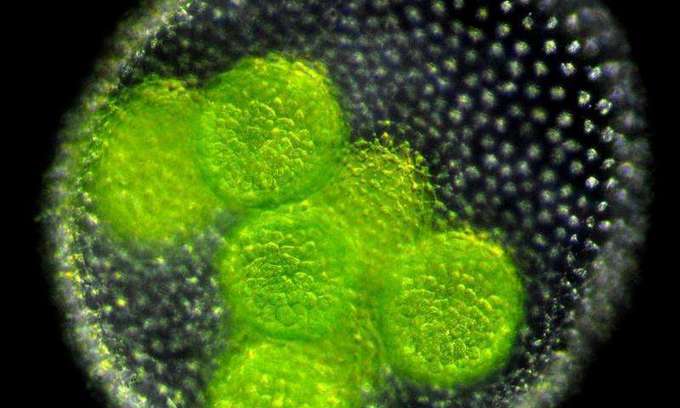Researchers captured the first 3-D video of a living algal embryo turning itself inside out
Researchers have captured the first 3D video of a living algal embryo (Volvox sp.) turning itself inside out, from a sphere to a mushroom shape and back again. The results could help unravel the mechanical processes at work during a similar process in animals, which has been called the “most important time in your life.”
Researchers from the University of Cambridge have captured the first three-dimensional images of a live embryo turning itself inside out. The images, of embryos of a green alga called Volvox, make an ideal test case to understand how a remarkably similar process works in early animal development.
Using fluorescence microscopy to observe the Volvox embryos, the researchers were able to test a mathematical model of morphogenesis – the origin and development of an organism’s structure and form – and understand how the shape of cells drives the process of inversion, when the embryo turns itself from a sphere to a mushroom shape and back again. Their findings are published today (27 April) in the journal Physical Review Letters.
The processes observed in the Volvox embryo are similar to the process of gastrulation in animal embryos – which biologist Lewis Wolpert called “the most important event in your life.” During gastrulation, the embryo folds inwards into a cup-like shape, forming the primary germ layers which give rise to all the organs in the body. Volvox embryos undergo a similar process, but with an additional twist: the embryos literally turn themselves right-side out during the process.
Gastrulation in animals results from a complex interplay of cell shape changes, cell division and migration, making it difficult to develop a quantitative understanding of the process. However, Volvox embryos complete their shape change only by changing cell shapes and the location of the connections between cells, and this simplicity makes them an ideal model for understanding cell sheet folding.
In Volvox embryos, the process of inversion begins when the embryos start to fold inward, or invaginate, around their middle, forming two hemispheres. Next, one hemisphere moves inside the other, an opening at the top widens, and the outer hemisphere glides over the inner hemisphere, until the embryo regains its spherical shape. This remarkable process takes place over approximately one hour.
Source: phys.org
See on Scoop.it – Virology and Bioinformatics from Virology.ca
